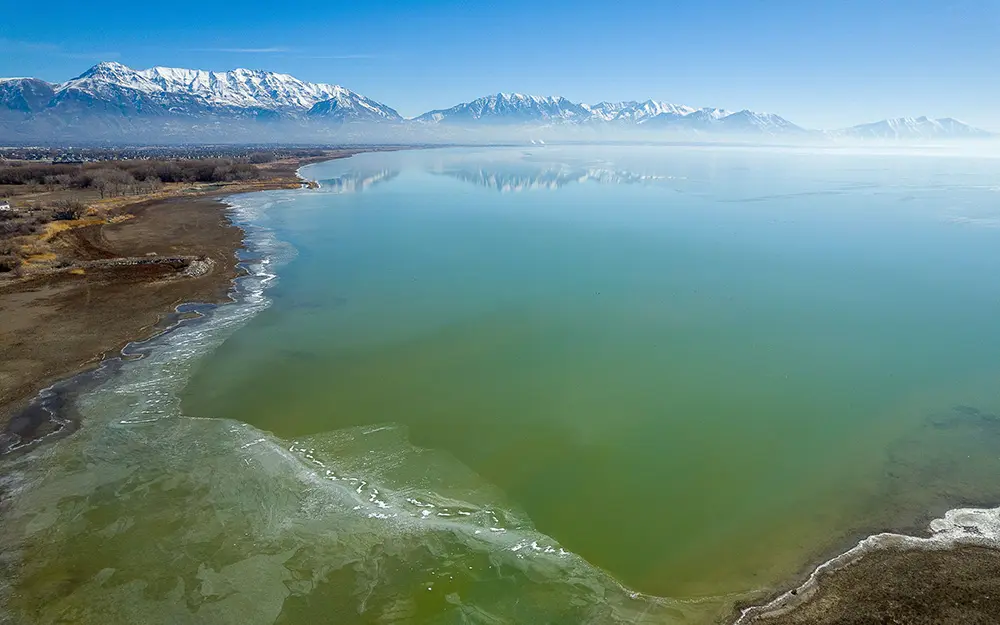Utah Lake

General data
- Name: Utah Lake
- Water system: Great Salt Lake
- Water type: Natural lake
- Progression: Jordan River (Utah) -> Great Salt Lake -> Planet Earth
- Climates:
- Continents: North America
- Countries: United States of America
Utah Lake is a shallow freshwater lake in the center of Utah County, Utah, United States. It lies in Utah Valley, surrounded by the Provo-Orem metropolitan area. The lakes only river outlet, the Jordan River, is a tributary of the Great Salt Lake. Evaporation accounts for 42% of the outflow of the lake, which leaves the lake slightly saline. The elevation of the lake is at 4,489 feet (1,368 m) above sea level. If the lakes water level rises above that, the pumps and gates on the Jordan River are left open. Recently the lake has been at a lower level because of a drought. Fish Parley P. Pratt visited Fort Utah in June 1849 and saw thousands of fish being caught by settlers and Timpanogots. He estimated that 5000 barrels of fish could be secured annually from the fishery. The winter of 1885–1886 caused much of the livestock to die. Leaders of The Church of Jesus Christ of Latter-day Saints elders sent members in the Salt Lake Valley to Utah Lake to obtain fish; an estimated 96,000 pounds (44,000 kg) of fish were brought back. The first commercial fishery also started the same year. At the 1870 General Conference of the LDS Church, a committee was appointed to develop fish culture because of the declining fish harvest in Utah Lake. By 1904, it became illegal to commercially catch any fish except for non-native species. At least 25 species of fish have been introduced into Utah Lakes. Thirteen introductions were unsuccessful. Carp, largemouth bass, white bass, black bullhead, channel catfish, walleye, goldfish, yellow perch, blue gill, and black crappie are found in abundance. The golden shiner and the fathead minnow are rarely found. Of the thirteen species of fish native to Utah Lake, one species is extinct (the Utah Lake sculpin), one is no longer present in the lake and is under review to see if it qualifies for protection under the Endangered Species Act (least chub),[73] one is already listed as endangered (the June sucker), and one is found in relative abundance throughout Utah (the Utah sucker). All other native fish are no longer extant in the lake.[61] The Bonneville cutthroat trout was historically the top predator fish in the ecosystem, but is now restricted to tributary streams.[61] A review in 2008 indicates that viable populations are distributed throughout its historic range and does not merit listing as a threatened or endangered species.[74] The Utah Lake sculpin was last found in 1928, and likely became extinct in the 1930s after severe drought lowered the lake levels, allowing much of the lake to freeze, overcrowding fish in unfrozen portions of the lake. This overcrowding and pollution from agricultural runoff are cited as probable causes of the fish's extinction.[75] The Bonneville redside shiner, mottled sculpin, leatherside chub, Utah chub, speckled dace, longnose dace, mountain whitefish and mountain sucker are no longer in the lake, but still exist in tributaries.[61] The June sucker was federally listed as an endangered species in 1986. The lower 5 miles (8.0 km) of the Provo River is the only known spawning location for the species.[76] Biologists have been rearing the June sucker in Red Butte Reservoir and releasing them into Utah Lake to help build the population. During the summer of 2005, over 8,000 June sucker were released into Utah Lake.[77] The June Sucker Recovery Implementation Program (JSRIP) coordinates and implements recovery actions for the June sucker.[78] Common carp, such as these in Lake Powell, are the dominant species of fish in the lake. The common carp was introduced in 1883 as a source of food after native species had been depleted by overfishing. It is now the most prevalent fish found in Utah Lake.[79][80] Carp makes up about 90% of the lake's biomass,[81] with an adult population numbering around 7.5 million. The average carp in the lake is about 5.3 pounds (2.4 kg), for a total of nearly 40,000,000 pounds (18,000,000 kg) of carp in the lake.[82] As early as 1901, fish and wildlife representatives noted that carp were causing the trout population in the lake to collapse.[35] Due to their habit of grubbing through bottom sediments for food, carp stir up sediments and increase the turbidity of the water. In addition, they destroy submerged vegetation that holds sediments in place and provides shelter for native fish populations. Without vegetation, winds can more easily stir up sediment from the bottom of the lake, which is already a problem due to the lake's shallowness, resulting in greater turbidity and less sunlight reaching the remaining vegetation. Without cover for their young, native fish, such as the June sucker, become easy prey for white bass, walleye, and other predators.[83] Efforts are underway to reduce the population of carp in Utah Lake by employing local commercial fishermen, led by Bill Loy, Jr. to remove 5 million pounds of carp each year, as part of the June Sucker Recovery Implementation Program's efforts to restore Utah Lake to a habitat in which the June sucker can survive. The intent is to cause a crash in the carp population which will allow the ecosystem to begin to rebuild and the June sucker to reestablish dominance in the lake.[84] The Utah Lake Commission has previously stated its goal is to remove 32 million pounds of carp from the lake, and more than 17 million pounds have been removed as of November 2019.[85]

 English
English
 Spanish
Spanish
 German
German
 French
French
 Serbian
Serbian
 Russian
Russian

